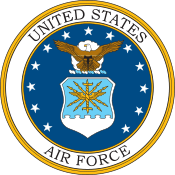Air Force Special Operations Command
Air Force Special Operations Command (AFSOC), headquartered at Hurlburt Field, Florida, is the special operations component of the United States Air Force. An Air Force major command (MAJCOM), AFSOC is also the U.S. Air Force component command to United States Special Operations Command (USSOCOM), a unified combatant command located at MacDill Air Force Base, Florida. AFSOC provides all Air Force Special Operations Forces (SOF) for worldwide deployment and assignment to regional unified combatant commands.
| Air Force Special Operations Command | |
|---|---|
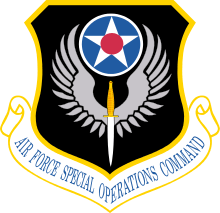 Shield of Air Force Special Operations Command | |
| Active | 10 February 1983 – present (37 years, 4 months) Detailed
|
| Country | |
| Branch | |
| Type | Major Command |
| Role | "Provide our Nation’s specialized airpower, capable across the spectrum of conflict … Any Place, Any Time, Anywhere"[2] |
| Size | 20,800 personnel authorized:[3] |
| Part of | |
| Headquarters | Hurlburt Field, Florida, U.S. |
| Nickname(s) | "Air Commandos"[4] |
| Motto(s) | "Any place. Any time. Anywhere"[5] |
| Decorations | Air Force Organizational Excellence Award Air Force Outstanding Unit Award[6] |
| Website | www |
| Commanders | |
| Commander | Lt Gen James C. Slife[7] |
| Deputy Commander | Maj Gen Vincent K. Becklund |
| Command Chief Master Sergeant | CCM Cory M. Olson |
| Executive Director | SES Donald E. Plater |
| Insignia | |
| Twenty-Third Air Force shield (former) (approved May 1983)[8] | .png) |
| Aircraft flown | |
| Attack | AC-130U/W/J, MQ-9 |
| Reconnaissance | U-28A |
| Transport | C-145A, C-146A, CV-22B |
| Tanker | MC-130H/P/J |
Before 1983, Air Force special operations forces were primarily assigned to the Tactical Air Command (TAC) and were generally deployed under the control of U.S. Air Forces in Europe (USAFE) or, as had been the case during the Vietnam War, Pacific Air Forces (PACAF). Just as it had relinquished control of the C-130 theater airlift fleet to Military Airlift Command (MAC) in 1975, TAC relinquished control of Air Force SOF to MAC in December 1982.
AFSOC was initially established on 10 February 1983 as Twenty-Third Air Force (23 AF), a subordinate numbered air force of MAC, with 23 AF headquarters initially established at Scott Air Force Base, Illinois. On 1 August 1987, 23 AF headquarters moved to Hurlburt Field, Florida.
Predecessor USAAF and USAF special operations units
World War II
- 1st Air Commando Group: Late 1943 – November 1945
- Operation Carpetbagger: Early 1944 – July 1945[9][10][11]
Korean War
- Air Resupply and Communications Service: 23 February 1951 – 12 October 1956
- Combined Command Reconnaissance Activities, Korea: December 1951 – December 1953
- B Flight, 6167th Operations Squadron: 1 April 1952 – 31 December 1953
- 6004th Air Intelligence Service Squadron: c. March 1951 – 1955
- 6006th Air Intelligence Service Squadron: c. 1953 – 1955
- 22nd Crash Rescue Boat Squadron: c. July 1952 – 1954
- 581st Air Supply and Communications Wing: July 1951 – September 1955
- 582nd Air Supply and Communications Wing
- 580th Air Supply and Communications Wing[11][12]
Early Cold War era
- 129th Air Resupply Group: April 1955 – c. 1975
- 130th Air Resupply Group: October 1955 – c. 1960
- 135th Air Resupply Group: August 1955 – c. 1971
- 143rd Special Operations Group: November 1955 – 1975
- 1045th Observation, Evaluation, and Training Group: 23 February 1951 – 1 January 1954[11][13]
Vietnam War era
- Jungle Jim / 4400th Combat Crew Training Squadron
- Farm Gate[14]
- Operation Waterpump
- Raven Forward Air Controllers
- Project 404
- Palace Dog
- 56th Air Commando Wing[11][15][16]
Lineage
- Established as Twenty-Third Air Force on 10 February 1983
- Activated on 1 March 1983
- Redesignated Air Force Special Operations Command and made a major command on 22 May 1990[6]
Assignments
- Military Airlift Command, 1 March 1983
- United States Air Force, 22 May 1990 – present[6]
Stations
- Scott AFB, Illinois, 1 March 1983
- Hurlburt Field, Florida, 1 August 1987 – present[17]
Components
- Air Forces Special Operations Center (redesignated 623d Air and Space Operations Center): 13 December 2005 – 1 January 2008
- Twenty-Third Air Force (Air Forces Special Operations Forces): 1 January 2008 – 4 April 2013
- AFSOC Operations Center: 4 April 2013 – present[18]
- 2d Air Division, 1 March 1983 – 1 February 1987
- Aerospace Rescue and Recovery Service, 1 March 1983 – 1 August 1989
- Air Rescue Service, 1 August 1989 – 1993
- 1st Special Operations Wing, 1 February 1987 – present
- 24th Special Operations Wing, 12 June 2012 – present
- 27th Special Operations Wing, 1 October 2007 – present
- 41st Rescue and Weather Reconnaissance Wing, 1 October 1983 – 1 August 1989
- 352d Special Operations Wing, 1 October 1983 – present
- 353d Special Operations Group, 6 April 1989 – present
- 375th Aeromedical Airlift Wing: 1 January 1984 – 1 February 1990
- 492d Special Operations Wing: 10 May 2017 – present
- 720th Special Tactics Group: 1 October 1987 – 12 June 2012
- 724th Special Tactics Group: 29 April 2011 – 12 June 2012
- 1550th Aircrew Training and Test Wing (later, 1550th Combat Crew Training Wing): 1 October 1983 – 21 May 1990
- USAF Special Operations School, 1 February 1987 – 22 May 1990
- Air Force Special Operations Training Center, 8 October 2008 – 11 February 2013
- Air Force Special Operations Air Warfare Center, 11 February 2013 – 10 May 2017[19]
Units
Air Force
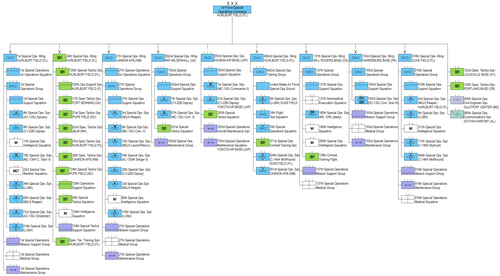
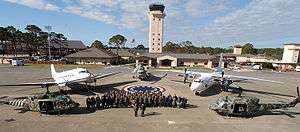
Air Force Special Operations Air Warfare Center belonging to the 6th Special Operations Squadron
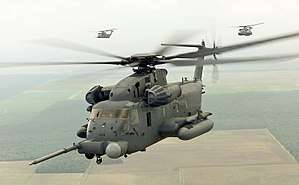
CV-22B Osprey
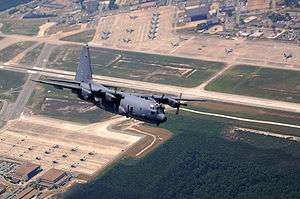
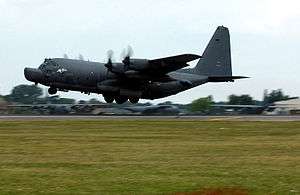
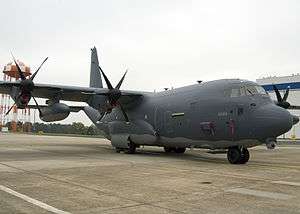
The following list contains the flying and Special Tactics squadrons of the Air Force Special Operations Command:
- 1st Special Operations Wing,[20] Hurlburt Field, Florida
- 1st Special Operations Group
- 4th Special Operations Squadron, AC-130U Spooky
- 8th Special Operations Squadron, CV-22B Osprey
- 15th Special Operations Squadron, MC-130H Combat Talon II
- 34th Special Operations Squadron, U-28A
- 65th Special Operations Squadron, MQ-9 Reaper
- 73d Special Operations Squadron, AC-130J Ghostrider[21]
- 319th Special Operations Squadron, U-28A
- 1st Special Operations Group
- 24th Special Operations Wing,[22] Hurlburt Field, Florida
- Special Tactics Training Squadron, Hurlburt Field, Florida
- 720th Special Tactics Group, Hurlburt Field, Florida
- 17th Special Tactics Squadron, Fort Benning, Georgia
- 21st Special Tactics Squadron, Pope Field, North Carolina
- 22nd Special Tactics Squadron, Joint Base Lewis-McChord, Washington
- 23rd Special Tactics Squadron, Hurlburt Field, Florida
- 26th Special Tactics Squadron, Cannon AFB, New Mexico
- 724th Special Tactics Group, Pope Field, North Carolina
- 24th Special Tactics Squadron, Pope Field
- 27th Special Operations Wing,[23] Cannon AFB, New Mexico
- 27th Special Operations Group
- 3rd Special Operations Squadron, MQ-9 Reaper
- 9th Special Operations Squadron, MC-130J Commando II
- 12th Special Operations Squadron, Expeditionary MQ-9 Reaper launch and recovery
- 16th Special Operations Squadron, AC-130W Stinger II
- 20th Special Operations Squadron, CV-22B Osprey
- 33rd Special Operations Squadron, MQ-9 Reaper
- 318th Special Operations Squadron, U-28A
- 27th Special Operations Group
- 352nd Special Operations Wing, RAF Mildenhall, UK (supporting EUCOM, AFRICOM, CENTCOM)
- 752nd Special Operations Group
- 7th Special Operations Squadron, CV-22B Osprey
- 67th Special Operations Squadron, MC-130J Commando II
- 321st Special Tactics Squadron
- 752nd Special Operations Group
- 353rd Special Operations Group, Kadena Air Base, Japan (supporting INDOPACOM)
- 1st Special Operations Squadron, MC-130J Commando II[24]
- 21st Special Operations Squadron, at Yokota Air Base (CV-22B Osprey)[25]
- 320th Special Tactics Squadron
- 492nd Special Operations Wing, Hurlburt Field, Florida[26]
- 492nd Special Operations Training Group
- United States Air Force Special Operations School[27]
- 6th Special Operations Squadron, U-28A, Duke Field, Florida
- 18th Flight Test Squadron
- 19th Special Operations Squadron, training AC-130U/J, MC-130H, U-28A crews
- 371st Special Operations Combat Training Squadron, ground training
- 524th Special Operations Squadron, C-146A Wolfhound, Duke Field, Florida
- 551st Special Operations Squadron, Cannon AFB, training AC-130W, MQ-9, MC-130J, CV-22B crews
- 492nd Special Operations Training Group
Air National Guard
- 137th Special Operations Wing, Oklahoma Air National Guard, Will Rogers Air National Guard Base, Oklahoma[28]
- 137th Special Operations Group
- 185th Special Operations Squadron, MC-12W Liberty
- 138th Combat Training Flight, ground training
- 137th Special Operations Group
- 193rd Special Operations Wing, Pennsylvania Air National Guard, Harrisburg Air National Guard Base, Pennsylvania[29]
- 193rd Special Operations Group
- 193rd Special Operations Squadron, EC-130J Commando Solo III
- 193rd Special Operations Group
Additionally the Air Force Special Operations Command would gain the following units from Air Mobility Command or Air Combat Command aligned Air National Guard wings:[29]
- 123rd Special Tactics Squadron, Kentucky Air National Guard, Louisville Air National Guard Base, Kentucky
- 125th Special Tactics Squadron, Oregon Air National Guard, Portland Air National Guard Base, Oregon
- 209th Special Operations Civil Engineer Squadron, Mississippi Air National Guard, Gulfport Combat Readiness Training Center, Mississippi
- 280th Special Operations Communications Squadron, Alabama Air National Guard, Dothan Regional Airport, Alabama
Air Force Reserve Command
The Air Force Reserve Command units of Air Force Special Operations Command are:
- 919th Special Operations Wing, Duke Field, Florida[30]
- 919th Special Operations Group
- 2nd Special Operations Squadron, MQ-9 Reaper, Hurlburt Field, Florida
- 5th Special Operations Squadron, U-28A
- 711th Special Operations Squadron, C-145A Skytruck
- 859th Special Operations Squadron, C-146A Wolfhound
- 919th Special Operations Group
Personnel and resources
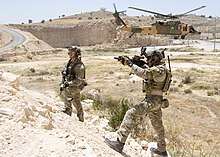
AFSOC has about 20,800 active-duty, Air Force Reserve, Air National Guard and civilian personnel.[31]
The commander of AFSOC is Lieutenant General James C. "Jim" Slife.
Major General Vincent K. Becklund [32] is Deputy Commander, and Chief Master Sergeant Cory M. Olson[33] is the Command Chief Master Sergeant, Air Force Special Operations Command.
The command's SOF units are composed of highly trained, rapidly deployable airmen who are equipped with specialized aircraft. These forces conduct global special operations missions ranging from precision application of firepower, to infiltration, aviation foreign internal defense, exfiltration, resupply and aerial refueling of SOF operational elements.
In addition to the pilots, combat systems officers, and enlisted aircrew who fly AFSOC's aircraft, there is a highly experienced support force of maintenance officers and enlisted aircraft maintenance personnel who maintain these complex aircraft and their support systems, a cadre of premier intelligence officers and enlisted intelligence specialists well versed in special operations, as well as logisticians, security forces and numerous other support officers and personnel.
Another aspect of AFSOC is Special Tactics, the U.S. Air Force's special operations ground force. Similar in ability and employment to Marine Special Operations Command (MARSOC), U.S. Army Special Forces and U.S. Navy SEALs, Air Force Special Tactics personnel are typically the first to enter combat and often find themselves deep behind enemy lines in demanding, austere conditions, usually with little or no support.
The command's Special Tactics Squadrons are led by Special Tactics Officers (STOs). Special Tactics Squadrons combine Combat Controllers, Tactical Air Control Party (TACP), Special Operations Weather Technicians, Pararescuemen (PJs) and Combat Rescue Officers (CROs) to form versatile SOF teams. AFSOC's unique capabilities include airborne radio and television broadcast for psychological operations, as well as combat aviation advisors to provide other governments military expertise for their internal development.
Due to the rigors of the career field, Special Tactics' year-long training is one of the most demanding in the military, with attrition rates between 80 and 90 percent. In an attempt to reduce the high attrition, Special Tactics is very selective when choosing their officers. Special Tactics Officers (STO) undergo a highly competitive process to gain entry into the Special Tactics career field, ensuring only the most promising and capable leaders are selected. STO leadership and role modeling during the difficult training reduces the attrition rate for enlisted trainees.
STO selection is a two-phase process. Beginning with Phase One, a board of veteran STOs reviews application packages consisting of letters of recommendation, fitness test scores, and narratives written by the applicants describing their career aspirations and reasons for applying. Based on Phase One performance, about eight to 10 applicants are invited to the next phase. Phase Two is a weeklong battery of evaluations, ranging from physical fitness and leadership to emotional intelligence and personality indicators. At the end of Phase Two, typically two to four applicants are selected to begin the year-plus Special Tactics training pipeline.
Aircraft
Current
AFSOC regularly operates the following aircraft:[34]
- AC-130J Ghostrider / AC-130U Spooky II / AC-130W Stinger II
- CV-22B Osprey
- C-32 (Boeing 757)
- EC-130J Commando Solo III
- MC-130H Combat Talon II / MC-130J Commando II
- C-145A Skytruck
- C-146A Wolfhound
- C-208B Caravan
- U-28A
- MQ-9 Reaper
- RQ-11 Raven
- Scan Eagle
- Wasp III
Additionally, AFSOC, through its Air Force Special Operations Air Warfare Center, possess and operates a small number of the following aircraft for its special training mission and Aviation Foreign Internal Defense (FID) missions:
- C-130E Hercules
- An-26 Curl
- C-47T Sky Train
- C-212 Aviocar
- CN-235-100
- Mi-17 Hip
- UH-1H and UH-1N Huey[35]
Future
New AC-130J and MC-130J aircraft based on the Lockheed Martin KC-130J Super Hercules tanker variant are being acquired and sent to certain AFSOC units. MC-130J aircraft have already entered service while the AC-130J continues developmental testing in preparation for an Initial Operational Capability (IOC) with AFSOC projected for FY 2017[36][37][38]
History
Twenty-Third Air Force (23 AF)
In December 1982, the Air Force transferred responsibility for Air Force special operations from Tactical Air Command (TAC) to Military Airlift Command (MAC). Consequently, in March 1983, MAC activated Twenty-Third Air Force (23 AF) at Scott Air Force Base, Illinois. This new numbered air force's responsibilities included worldwide missions of special operations, combat rescue, weather reconnaissance and aerial sampling, security support for intercontinental ballistic missile sites, training of USAF helicopter and HC-130 crewmen, pararescue training, and medical evacuation.[11]
Operation Urgent Fury
In October 1983, 23 AF helped rescue Americans from the island nation of Grenada. During the seven-day operation, centered at Point Salines Airport, 23 AF furnished MC-130s, AC-130s, aircrews, maintenance, and support personnel. An EC-130 from the 193rd Special Operations Wing of the Air National Guard (ANG) also played a psy-war role. Lieutenant Colonel (later Major General) James L. Hobson, Jr., an MC-130 pilot and commander of the 8th Special Operations Squadron, was later awarded the Mackay Trophy for his actions in leading the air drop on the Point Salines Airport.[39]
U.S. Special Operations Command
In May 1986, the Goldwater-Nichols Department of Defense Reorganization Act led to the formation of the United States Special Operations Command. Senators William Cohen and Sam Nunn introduced the Senate bill, and the following month Congressman Dan Daniel introduced a like measure in the House of Representatives. The key provisions of the legislation formed the basis to amend the 1986 Defense Authorizations Bill. This bill, signed into law in October 1986, in part directed the formation of a unified command responsible for special operations. In April 1987, the DoD established the United States Special Operations Command (USSOCOM) at MacDill Air Force Base, Florida, and Army GEN James J. Lindsay assumed command. Four months later, 23 AF moved its headquarters from Scott AFB to Hurlburt Field, Florida.
In August 1989, Gen Duane H. Cassidy, USAF, CINCMAC, divested 23 AF of its non-special operations units, e.g., search and rescue, weather reconnaissance, etc. Thus, 23 AF served a dual role: still reporting to MAC, but also functioning as the air component to USSOCOM.[11]
Operation Just Cause
From late December 1989 to early January 1990, 23 AF participated in the invasion of the Republic of Panama during Operation Just Cause. Special operations aircraft included both active duty AC-130H and Air Force Reserve AC-130A Spectre gunships, EC-130 Volant Solo psychological operations aircraft from the Air National Guard, HC-130P/N Combat Shadow tankers, MC-130E Combat Talons, and MH-53J Pave Low and MH-60G Pave Hawk helicopters. Special tactics Combat Controllers and Pararescuemen provided important support to combat units.[11]
Spectre gunship crews of the 1 SOW earned the Mackay Trophy and Tunner Award for their efforts, with an Air Force Reserve AC-130A Spectre crew from the 919th Special Operations Group (919 SOG) earning the President's Award. An active duty 1st SOW MC-130 Combat Talon crew ferried the captured Panamanian President, Manuel Noriega, to prison in the United States. Likewise, the efforts of the 1 SOW maintenance people earned them the Daedalian Award.[11]
On 22 May 1990, General Larry D. Welch, USAF, the Chief of Staff of the Air Force, redesignated Twenty-Third Air Force as Air Force Special Operations Command (AFSOC). This new major command consisted of three wings: the 1st, 39th and 353rd Special Operations Wings as well as the 1720th Special Tactics Group (1720 STG), the U.S. Air Force Special Operations School, and the Special Missions Operational Test and Evaluation Center.[11]
Currently, after major redesignations and reorganizations, AFSOC direct reporting units include the 16th Special Operations Wing, the 352nd Special Operations Group, the 353rd Special Operations Group, the 720th Special Tactics Group (720 STG), the USAF Special Operations School and the 18th Flight Test Squadron (18 FLTS). During the early 1990s a major reorganization occurred within AFSOC. The 1720 STG became the 720 STG in March 1992; the transfer of ownership of Hurlburt Field from Air Mobility Command (AMC, and formerly MAC) to AFSOC in October 1992, followed by the merger of the 834th Air Base Wing (834 ABW) into the 1 SOW, which assumed host unit responsibilities. A year later the 1 SOW became the 16 SOW in a move to preserve Air Force heritage.[40][41][42]
Meanwhile, the Special Missions Operational Test and Evaluation Center (SMOTEC), which explored heavy lift frontiers in special operations capabilities, while pursuing better equipment and tactics development, was also reorganized. In April 1994, the Air Force, in an effort to standardize these types of organizations, redesignated SMOTEC as the 18th Flight Test Squadron (18 FLTS).[43]
Gulf War
From early August 1990 to late February 1991, AFSOC participated in Operation Desert Shield and Operation Desert Storm, the protection of Saudi Arabia and liberation of Kuwait. Special tactics personnel operated throughout the theater on multiple combat control and combat rescue missions. Special operations forces performed direct action missions, combat search and rescue, infiltration, exfiltration, air base ground defense, air interdiction, special reconnaissance, close air support, psychological operations, and helicopter air refuelings. Pave Low crews led the helicopter assault on radars to blind Iraq at the onset of hostilities, and they also accomplished the deepest rescue for which they received the Mackay Trophy.[44]
MC-130E/H Combat Talons dropped the BLU-82, the largest conventional bombs of the war and, along with MC-130P Combat Shadows, dropped the most psychological warfare leaflets, while AC-130A and AC-130H Spectre gunships provided valuable fire support and armed reconnaissance. However, the AC-130 community also suffered the single greatest combat loss of coalition air forces with the shoot down of an AC-130H, call sign Spirit 03, by an Iraqi SA-7 Grail surface-to-air missile. All fourteen crew members aboard Spirit 03 were killed.[45][46]
AFSOC
Post-Gulf War
In December 1992, AFSOC special tactics and intelligence personnel supported Operation Restore Hope in Somalia. In late 1994, AFSOC units spearheaded Operation Uphold Democracy in Haiti, and in 1995 Operation Deliberate Force in the Balkans.[47]
Operation Enduring Freedom
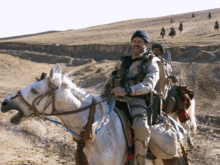
The terrorist attacks on the World Trade Center in New York City, and the Pentagon, Washington D.C., on 11 September 2001 pushed the United States special operations forces to the forefront of the war against terrorism. By the end of September 2001, AFSOC deployed forces to southwest Asia for Operation Enduring Freedom – Afghanistan to help destroy the al Qaeda terrorist organization and remove the Taliban regime in Afghanistan. AFSOC airpower delivered special tactics forces to the battle ground and they in turn focused U.S. airpower and allowed Afghanistan's Northern Alliance ground forces to dispatch the Taliban and al Qaeda from Afghanistan. AFSOC personnel also deployed to the Philippines to help aid that country's efforts against terrorism.[47]
US Air Force Special Operations had a long-term presence in the Philippines during Operation Enduring Freedom – Philippines.[48]
Operation Iraqi Freedom
In March 2003, AFSOC again deployed forces to southwest Asia this time in support of what would become Operation Iraqi Freedom – the removal of Saddam Hussein and his Baathist government. The command's personnel and aircraft teamed with SOF and conventional forces to quickly bring down Saddam Hussein's government by May 2003. AFSOC forces continued to conduct operations in support of the new Iraqi government against insurgents and terrorists.[47]
Commanders
AFSOC has had eleven commanders since its inception in 1990.
| List of AFSOC Commanders | ||
|---|---|---|
| Name | Tenure start | Tenure End |
| Maj Gen Thomas E. Eggers | 22 May 1990 | 20 June 1991 |
| Maj Gen Bruce L. Fister | 21 June 1991 | 21 July 1994 |
| Maj Gen James L. Hobson, Jr. | 22 July 1994 | 8 July 1997 |
| Maj Gen Charles R. Holland | 9 July 1997 | 4 August 1999 |
| Lt Gen Maxwell C. Bailey | 5 August 1999 | 15 January 2002 |
| Lt Gen Paul V. Hester | 16 January 2002 | 30 June 2004 |
| Lt Gen Michael W. Wooley | 1 July 2004 | 26 November 2007 |
| Lt Gen Donald C. Wurster | 27 November 2007 | 24 June 2011 |
| Lt Gen Eric E. Fiel | 24 June 2011 | 1 July 2014 |
| Lt Gen Bradley A. Heithold | 1 July 2014 | 19 July 2016 |
| Lt Gen Marshall B. Webb | 19 July 2016 | 28 June 2019 |
| Lt Gen Jim Slife | 28 June 2019 | present |
Contingency operations
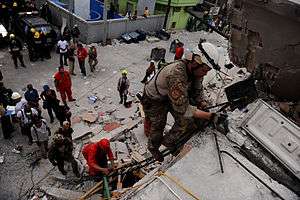
| Date(s) | Operation |
|---|---|
| 1975 | Mayaguez incident, Cambodia |
| 1975 | Operation Eagle Pull, Cambodia |
| 1975 | Operation Frequent Wind, Vietnam |
| 1976 | Operation Fluid Drive, Lebanon |
| 1978 | Zaire Airlift |
| 1980 | Operation Eagle Claw, Iran |
| 1981 | Kidnapping of U.S. Army Brigadier General James Dozier, Italy |
| 1981 | Gulf of Sidra incident, Libya |
| 1983 | Operation Urgent Fury, Grenada |
| 1983 | Operation Big Pine, Honduras |
| 1983–1985 | Operation Bat, Bahamas, Turks and Caicos |
| 1983–1988 | Operation Bield Kirk, Operation Blue Flame, Operation Blinking Light, El Salvador |
| 1984 | Salvadorean President José Napoleón Duarte's daughter kidnapping, El Salvador |
| 1985 | TWA Flight 847 plane hijacking, Algeria/Lebanon |
| 1985 | Achille Lauro hijacking, Mediterranean Sea |
| 1986 | Operation El Dorado Canyon, Libya |
| 1986 | Pan Am Flight 73 plane hijacking, Pakistan |
| 1987–1988 | Operation Earnest Will, Operation Prime Chance, Persian Gulf |
| 1988 | Operation Golden Pheasant, Honduras |
| 1989 | Operation Safe Passage, Afghanistan |
| 1989 | Operation Poplar Tree, El Salvador |
| 1989 | 1989 Philippine coup attempt, Philippines |
| 1989 | Operation Just Cause, Panama |
| 1990 | Operation Promote Liberty, Panama |
| 1990 | Civilian evacuation, Liberia |
| 1990–1991 | Operation Desert Shield, Operation Desert Storm, Saudi Arabia, Kuwait, Iraq |
| 1991 | Operation Eastern Exit, Somalia |
| 1991–2003 | Operation Provide Comfort I–III, Operation Northern Watch, Turkey, Iraq |
| 1991 | Operation Sea Angel, 1991 Bangladesh cyclone relief, Bangladesh |
| 1991 | Operation Fiery Vigil, Philippines |
| 1991 | Operation Desert Calm, Saudi Arabia |
| 1991–2003 | Operation Southern Watch, Kuwait |
| 1992 | Operation Silver Anvil, Sierra Leone |
| 1992–1994 | Operation Provide Promise I–II, Italy, Yugoslavia |
| 1992–1993 | Operation Restore Hope, Somalia |
| 1993–1995 | Operation Continue Hope I–III, Somalia |
| 1993 | Operation Deny Flight, Yugoslavia |
| 1993 | Operation Silver Hope, Ukraine |
| 1994 | Operation Restore Democracy, Operation Uphold Democracy, Haiti |
| 1994 | Operation Support Hope, Rwanda |
| 1995 | Operation United Shield, Somalia |
| 1995–1996 | Operation Deliberate Force, Operation Joint Endeavor, Operation Joint Guard, Italy, Yugoslavia, Bosnia |
| 1996 | Search and Rescue support for U.S. Secretary of Commerce Ron Brown CT-43 crash, Croatia |
| 1996 | Operation Assured Response, evacuation, Liberia |
| 1996 | Operation Guardian Retrieval, Uganda |
| 1996 | Operation Pacific Bridge, Palau |
| 1996 | Operation Guardian Assistance, Rwanda |
| 1997 | Operation Silver Wake, evacuation, Albania |
| 1997 | Operation Guardian Angel, Yugoslavia |
| 1997 | Operation Firm Response, evacuation, Republic of Congo |
| 1997 | Operation High Flight, Namibia |
| 1998 | Operation Desert Thunder, Persian Gulf |
| 1998 | Operation Desert Fox, Iraq |
| 1999 | Operation Allied Force, Serbia, Kosovo |
| 2000 | Operation Atlas Response, flood relief, Mozambique |
| 2000 | Operation Fiery Relief, volcano relief, Philippines |
| 2001 | Operation Valiant Return, China |
| 2001–present | Operation Enduring Freedom, Global War on Terror |
| 2002 | Operation Autumn Return, evacuation, Côte d'Ivoire |
| 2003 | Operation Shining Express, evacuation, Liberia |
| 2003–2011 | Operation Iraqi Freedom, Iraq |
| 2003–2008 | Operation Willing Spirit, Columbia |
| 2004 | Operation Atlas Shield, Greece |
| 2004 | Operation Secure Tomorrow, Haiti |
| 2005–2005 | Operation Unified Assistance, Indian Ocean, Southeast Asia |
| 2005 | Task Force Katrina, hurricane relief, United States |
| 2006 | evacuation, Lebanon |
| 2008 | Operation Aster Silver, evacuation, Chad |
| 2008 | Operation Assured Delivery, Georgia |
| 2008 | Operation Olympic Titan, Pacific Ocean |
| 2010 | Operation Unified Response, earthquake relief, Haiti |
| 2011 | Operation Tomodachi, earthquake and tsunami relief, Japan |
| 2011 | Operation Odyssey Dawn, Libya |
| 2013 | Operation Damayan, typhoon relief, Philippines |
Gallery
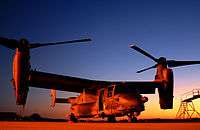 AFSOC's first CV-22B Osprey at sunset, Hurlburt Field, Florida
AFSOC's first CV-22B Osprey at sunset, Hurlburt Field, Florida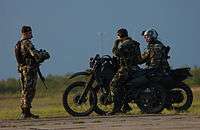 Combat Controllers practice seizing an airfield
Combat Controllers practice seizing an airfield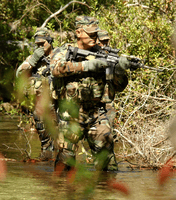 AFSOC Special Operations Weathermen
AFSOC Special Operations Weathermen.png) MC-130P Combat Shadow aircraft punching flares
MC-130P Combat Shadow aircraft punching flares
See also
- V-22 Osprey
- Air Resupply And Communications Service[50]
References
- "Air Force Special Operations Command (USAF)". af.mil. Archived from the original on 22 October 2017. Retrieved 4 May 2018.
- "AFSOC "About Us"". afsoc.af.mil. Archived from the original on 22 October 2017. Retrieved 11 January 2018.
- "Archived copy" (PDF). Archived (PDF) from the original on 22 March 2016. Retrieved 2 June 2016.CS1 maint: archived copy as title (link)
- "Air Commandos". af.mil. Archived from the original on 22 October 2017. Retrieved 4 May 2018.
- "United States Air Force". m.facebook.com. Archived from the original on 4 May 2018. Retrieved 4 May 2018.
- Bailey, Carl E. (9 November 2010). "Factsheet Air Force Special Operations Command (USAF)". Air Force Historical Research Agency. Archived from the original on 22 October 2017. Retrieved 30 October 2017.
- Staff Sgt. Lynette M. Rolen (28 June 2019). "Air Force Special Operations Command > Home > News > Article Display". www.afsoc.af.mil/. Retrieved 7 July 2019.
- Department of Defense. Department of the Navy. Naval Imaging Command. 1988-ca. 1993 (Predecessor); Department of Defense. Defense Audiovisual Agency (Predecessor); Department of Defense. American Forces Information Service. Defense Visual Information Center. 1994– (12 May 1983). Approved insignia for: 23rd Air Force. Series: Combined Military Service Digital Photographic Files, 1921 – 2008. Archived from the original on 7 November 2017. Retrieved 4 May 2018 – via US National Archives Research Catalog.
- "The Carpetbagger Photographic Archives". Archived from the original on 7 March 2015.
- ZenosWarbirds (29 May 2013). "Operation Carpetbagger: B-24s drop agents and supplies into occupied Europe in WW2". Archived from the original on 27 January 2016 – via YouTube.
- "Archived copy" (PDF). Archived (PDF) from the original on 8 March 2016. Retrieved 8 March 2016.CS1 maint: archived copy as title (link)
- Haas, Michael E., "Apollo’s Warriors: US Air Force Special Operations during the Cold War", Air University Press, Maxwell AFB, Alabama, 1997, page 36.
- Haas, Apollo's Warriors: U.S. Special Operations During the Cold War
- "Topic: A-26A/B-26K Counter Invader Farm Gate Program – Bien Hoa AB Association". Archived from the original on 8 March 2016.
- "Nakhon Phanom During The Secret War 1962–1975". Archived from the original on 23 February 2011.
- "The Air Commando Association – Air Commando and Special Operations Combat". Archived from the original on 3 October 2015.
- "Air Force Special Operations Command Brief History > Air Force Special Operations Command > Display". Archived from the original on 8 March 2016.
- 23rd AF deactivates Archived 15 May 2013 at the Wayback Machine. Afsoc.af.mil. Retrieved on 21 July 2013.
- AFSOC stands up Air Warfare Center Archived 17 February 2013 at the Wayback Machine. Afsoc.af.mil. Retrieved on 21 July 2013.
- "1st SOW units". Hurlburt Field Public Affairs. 4 March 2015. Retrieved 25 May 2018.
- "Hurlburt Field reactivates 73d SOS". Hurlburt Field Public Affairs. 23 February 2018. Retrieved 25 May 2018.
- "24th SOW units". 24th Special Operations Wing Public Affairs. 20 February 2015. Retrieved 25 May 2018.
- . 24th Special Operations Wing Public Affairs. 1 January 2017 http://www.cannon.af.mil/units/27th-Special-Operations-Group.aspx. Retrieved 25 May 2018. Missing or empty
|title=(help) - 1st Lieutenant Douglas, Renee. "The 353rd SOG bids farewell to the Combat Talon II". 353rd Special Operations Group. Retrieved 27 April 2020.
- "Special operations Osprey squadrons stand up at US air base in Tokyo". Stars and Stripes. Retrieved 27 April 2020.
- "Archived copy". Archived from the original on 8 May 2014. Retrieved 7 May 2014.CS1 maint: archived copy as title (link)
- "Air Force Special Operations Command > Units > Air Force Special Operations Air Warfare Center". Archived from the original on 4 March 2016. Retrieved 7 March 2016.
- "137th Special Operations Wing Units". 137th Special Operations Wing. Retrieved 27 April 2020.
- "Air Force Special Operations Command > Home". Archived from the original on 20 January 2015.
- "We are the 919th Special Operations Wing". 919th Special Operations Wing. Retrieved 27 April 2020.
- U.S. Seeks Faster Deployment; Smaller, More Flexible Special-Operations Teams Would Tackle Emerging Threats Under New Plan Archived 27 October 2017 at the Wayback Machine 7 May 2012
- "MAJOR GENERAL VINCENT K. BECKLUND > Air Force Special Operations Command > Display".
- "CHIEF MASTER SERGEANT CORY M. OLSON > Air Force Special Operations Command > Display".
- USAF Special Operations Command Archived 2 February 2007 at the Wayback Machine Official Site.
- "6th Special Operations Squadron – Defense Media Network". Archived from the original on 4 March 2016.
- FlightGlobal.com: Lockheed Martin C-130J selected for new special operations role Archived 30 June 2008 at the Wayback Machine, by Stephen Trimble, Washington DC, 18 June 2008; accessed: 20 February 2012
- "MC-130J Commando II > U.S. Air Force > Fact Sheet Display". Archived from the original on 4 March 2016.
- "AC-130J Ghostrider > U.S. Air Force > Fact Sheet Display". Archived from the original on 8 March 2016.
- "MAJOR GENERAL JAMES L. HOBSON JR. > U.S. Air Force > Biography Display". Archived from the original on 8 March 2016.
- Pike, John. "Air Force Special Operations Command". Archived from the original on 2 May 2016.
- Pike, John. "Hurlburt Field". Archived from the original on 3 March 2016.
- "Archived copy". Archived from the original on 15 March 2016. Retrieved 8 March 2016.CS1 maint: archived copy as title (link)
- Pike, John. "18th Flight Test Squadron [18th FLTS]". Archived from the original on 11 September 2015.
- "25th Anniversary of Desert Storm". Archived from the original on 9 March 2016.
- "In Memory Of "Spirit 03" Jan 31, 1991". Archived from the original on 8 March 2016.
- "In memory of Spirit 03". Archived from the original on 8 March 2016.
- "Archived copy" (PDF). Archived (PDF) from the original on 8 March 2016. Retrieved 8 March 2016.CS1 maint: archived copy as title (link)
- Neville, Leigh, Special Forces in the War on Terror (General Military), Osprey Publishing, 2015 ISBN 978-1472807908, p.184-185
- "Archived copy". Archived from the original on 19 March 2014. Retrieved 5 April 2014.CS1 maint: archived copy as title (link)
- Trest, Warren A., "Air Commando One: Heinie Aderholt And America's Secret Air Wars", Smithsonian Institution Press, Washington, D.C., London, 2000, Library of Congress card number 99-053643, ISBN 978-1-56098-807-6
Further reading
- Chinnery, Philip D. Any Time, Any Place: Fifty Years of the USAF Air Commando and Special Operations Forces, 1944–1994. Annapolis, Md: Naval Institute Press, 1994. ISBN 1557500371
- Haas, Michael E. Apollo's Warriors: U.S. Air Force Special Operations During the Cold War. 2002, University Press of the Pacific, Honolulu. ISBN 9781410200099.
- Hebert, Adam J. "The Air Commandos". Air Force Magazine, March 2005 (vol. 88, no. 3).
- Marquis, Susan L. Unconventional Warfare: Rebuilding U.S. Special Operations Forces. Washington, D.C.: Brookings Institution, 1997. ISBN 0815754760
- Pushies, Fred J. Deadly Blue Battle Stories of the U.S. Air Force Special Operations Command. New York: American Management Assoc, 2009. <http://www.books24x7.com/marc.asp?bookid=32471>. ISBN 9780814413616
- Sine, William F. Guardian Angel: Life and Death Adventures with Pararescue, the World's Most Powerful Commando Rescue Force. Havertown, Pa: Casemate, 2012. ISBN 9781612001227
External links
| Wikimedia Commons has media related to Air Force Special Operations Command. |
- Air Force Special Operations Command home page—Official AFSOC public site
- AFSOC Factsheet public site
- United States Air Force official website
- ShadowSpear Special Operations: AFSOC
